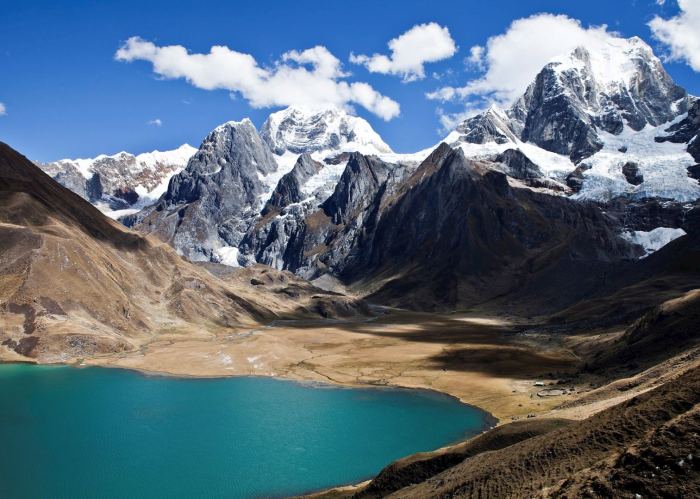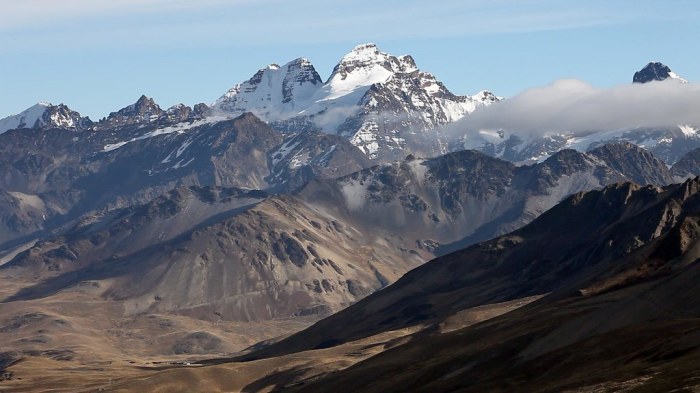La desglaciación de la cordillera andina, the deglaciation of the Andes, is a pressing environmental issue with far-reaching implications. As global temperatures rise and human activities intensify, the Andean glaciers are melting at an alarming rate, posing significant challenges to water resources, ecosystems, and human populations.
This article delves into the causes and impacts of Andean glacier melt, exploring the role of climate change, deforestation, and carbon emissions. It also examines the methods used to monitor glacier melt, the challenges associated with predicting and adapting to glacier loss, and strategies for mitigating its impacts.
Causes of Andean Glacier Melt

The Andean glaciers are experiencing unprecedented rates of melting due to a combination of factors. Rising global temperatures, primarily driven by human activities such as deforestation and carbon emissions, have significantly contributed to the observed decline in glacier mass.
Impact of Rising Global Temperatures
Global temperatures have increased by approximately 1.1 degrees Celsius since the late 19th century, leading to a substantial increase in the rate of glacier melt. As temperatures rise, the snowpack on glaciers melts faster and the freezing line moves to higher elevations, reducing the overall size of the glaciers.
Role of Human Activities
Human activities have played a significant role in accelerating glacier melt. Deforestation, particularly in the Amazon rainforest, reduces the amount of moisture available for precipitation in the Andean region. Carbon emissions from burning fossil fuels and other industrial processes release greenhouse gases into the atmosphere, further contributing to global warming and glacier melt.
Data and Evidence
Satellite imagery and field observations have documented the dramatic loss of Andean glaciers in recent decades. For example, the Chacaltaya Glacier in Bolivia, once the highest ski resort in the world, has completely disappeared due to melting.
Impacts of Andean Glacier Melt

The melting of Andean glaciers has far-reaching consequences for the region’s water resources and ecosystems.
Consequences on Water Resources
Glaciers serve as natural reservoirs, storing water during the wet season and releasing it gradually during the dry season. Glacier melt provides a critical source of water for drinking, irrigation, and hydropower in the Andean region. As glaciers recede, the availability of water for these purposes is threatened.
Impacts on Local Communities and Ecosystems
The loss of glaciers can have severe impacts on local communities that rely on glacier-fed rivers for their water supply. Reduced water availability can lead to water shortages, crop failures, and economic hardship. Glacier melt also affects ecosystems, as the loss of glacier-fed rivers can disrupt the flow of nutrients and alter the habitats of aquatic species.
Monitoring and Adaptation Strategies: La Desglaciación De La Cordillera Andina

Monitoring Andean glacier melt is essential for understanding the extent of the problem and developing strategies to adapt to its impacts.
Methods for Monitoring
Glacier melt is monitored using a variety of methods, including remote sensing (e.g., satellite imagery) and field observations (e.g., ground-based measurements of glacier mass balance). These methods provide data on glacier extent, thickness, and movement.
Challenges of Prediction and Adaptation
Predicting and adapting to glacier loss is challenging. The rate of glacier melt can vary significantly depending on factors such as local climate conditions and the size and shape of the glaciers. Adaptation strategies, such as water conservation and the development of alternative water sources, are crucial for mitigating the impacts of glacier melt.
Long-Term Implications

The long-term consequences of Andean glacier melt extend beyond water security and local communities.
Climate Implications
Glaciers play a crucial role in regulating the regional climate. They reflect sunlight and cool the surrounding air, helping to maintain a stable climate. Glacier melt can lead to changes in local and regional weather patterns, including increased temperatures and changes in precipitation.
Biodiversity and Human Populations
Glacier-fed rivers support diverse aquatic ecosystems. Glacier melt can disrupt these ecosystems, leading to the loss of biodiversity. Additionally, glacier melt can threaten human populations by increasing the risk of flooding and landslides.
Need for Further Research, La desglaciación de la cordillera andina
Further research is needed to better understand the long-term impacts of Andean glacier melt and to develop effective adaptation strategies. This includes research on the interactions between glaciers, climate, and ecosystems, as well as the potential socio-economic consequences of glacier loss.
FAQ Section
What are the main causes of Andean glacier melt?
The main causes of Andean glacier melt are rising global temperatures and human activities, such as deforestation and carbon emissions.
What are the impacts of Andean glacier melt?
The impacts of Andean glacier melt include reduced water availability for drinking, irrigation, and hydropower, as well as potential impacts on local communities and ecosystems.
How is Andean glacier melt monitored?
Andean glacier melt is monitored using remote sensing and field observations.
What are the challenges associated with predicting and adapting to glacier loss?
The challenges associated with predicting and adapting to glacier loss include the complexity of climate models and the difficulty of implementing effective adaptation strategies.
What are some strategies for mitigating the impacts of glacier melt?
Strategies for mitigating the impacts of glacier melt include water conservation and alternative energy sources.